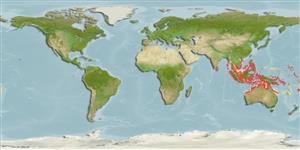Common names from other countries
>
Atheriniformes (Silversides) >
Atherinidae (Silversides) > Atherinomorinae
Etymology: Atherinomorus: Greek, atherina, the Greek name for the eperlane + Greek, moros = silly, stupid (Ref. 45335).
More on authors: Quoy & Gaimard.
Environment: milieu / climate zone / depth range / distribution range
Ecologia
marinhas; estuarina associadas(os) a recifes. Tropical; 19°N - 24°S
Western Central Pacific: Philippines and Micronesia to northern Australia and the Solomon Islands.
Tamanho / Peso / Idade
Maturity: Lm ? range ? - ? cm
Max length : 9.0 cm SL macho/indeterminado; (Ref. 1602)
Espinhos dorsais (total) : 5 - 7; Raios dorsais (total) : 8 - 10; Espinhos anais: 1; Raios anais : 11 - 14. Pectoral blotch, when present, distinct; midlateral band silvery (Ref. 9760). Ramus of premaxilla not extending past vertical through anterior border of pupil; Free edge of lower jaw sloping backwards and upwards and with distinct tubercle at posterior end.
Found in shallow coastal waters. Schools with A. lacunosus, A. ogilbyi, Craterocephalus mugiloides, and Hypoatherina temminckii, in the coasts of northern Australia.
Ciclo de vida ou comportamento de acasalamento
Maturities | Reprodução | Spawnings | Egg(s) | Fecundities | Larvas
Ivantsoff, W. and L.E.L.M. Crowley, 1991. Review of the Australian silverside fishes of the genus Atherinomorus (Atherinidae). Aust. J. Mar. Freshwat. Res. 42(5):479-505. (Ref. 2909)
Status na Lista Vermelha da UICN (Ref. 130435)
CITES (Ref. 128078)
Not Evaluated
Ameaça para os humanos
Harmless
Uso pelos humanos
Pescarias: sem interesse
Ferramentas
Relatórios especiais
Baixar XML
Fontes da internet
Estimates based on models
Preferred temperature (Ref.
115969): 26.7 - 29.1, mean 28.3 (based on 890 cells).
Índice de diversidade filogenética (Ref.
82804): PD
50 = 0.5005 [Uniqueness, from 0.5 = low to 2.0 = high].
Bayesian length-weight: a=0.00562 (0.00244 - 0.01296), b=3.11 (2.91 - 3.31), in cm Total Length, based on LWR estimates for this (Sub)family-body shape (Ref.
93245).
Nível Trófico (Ref.
69278): 3.4 ±0.45 se; based on food items.
Resiliência (Ref.
120179): Elevada, tempo mínimo de duplicação da população menor que 15 meses (Preliminary K or Fecundity.).
Fishing Vulnerability (Ref.
59153): Low vulnerability (10 of 100).
